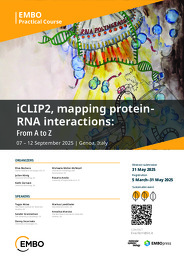About the Practical Course
RNA is increasingly recognized as a key therapeutic target, driving the development of RNA-based therapeutics for a broad spectrum of diseases. RNA-binding proteins (RBPs) play a fundamental role in regulating RNA function, and identifying their targets and molecular interactions is essential for understanding their cellular roles.
The advent of high-throughput RNA interaction mapping techniques, such as UV crosslinking and immunoprecipitation (CLIP) coupled with next-generation sequencing, has revolutionized our understanding of RNA regulation. In recent years, advanced CLIP methodologies have been developed that enhance efficiency, speed, and analytical depth, providing a more comprehensive view of protein-RNA interactions.
This course offers hands-on training in the iCLIP2 protocol, a cutting-edge high-resolution CLIP technique for transcriptome-wide RNA-interaction mapping. The key objectives are to:
(i) Guide participants through the complete iCLIP2 workflow, from experimental setup to data generation.
(ii) Introduce and apply bioinformatics approaches for CLIP data analysis, equipping participants with essential computational skills.
(iii) Explore alternative and specialized CLIP protocols, including seCLIP, kinCLIP, and miCLIP2, discussing their unique advantages and applications.
Theoretical sessions will cover the principles and advancements of iCLIP2 and related CLIP protocols, while practical bioinformatics modules will provide essential tools for analyzing large-scale interaction datasets. This course is designed for PhD students, postdoctoral researchers, and scientists working in RNA biology, transcriptomics, and RNA-based therapeutics, offering valuable insights into cutting-edge methodologies in RNA regulation research.
Image credits: Heng-Chang Chen
About EMBO Courses and Workshops
EMBO Courses and Workshops are selected for their excellent scientific quality and timelines, provision of good networking activities for all participants and speaker gender diversity (at least 40% of speakers must be from the underrepresented gender).
Organisers are encouraged to implement measures to make the meeting environmentally more sustainable.







